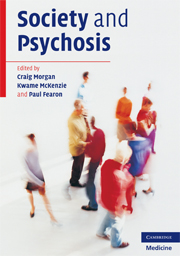Book contents
- Frontmatter
- Contents
- Contributors
- Acknowledgements
- 1 Introduction
- 2 Climate change in psychiatry: periodic fluctuations or terminal trend?
- Part I Theoretical and conceptual foundations
- Part II Social factors and the onset of psychosis
- 6 Society, place and space
- 7 Childhood adversity and psychosis
- 8 Family environment and psychosis
- 9 Adult adversity: do early environment and genotype create lasting vulnerabilities for adult social adversity in psychosis?
- 10 Migration, ethnicity and psychosis
- Part III Social factors and the outcome of psychosis
- Part IV Models and conclusions
- Index
- References
8 - Family environment and psychosis
from Part II - Social factors and the onset of psychosis
Published online by Cambridge University Press: 07 December 2009
- Frontmatter
- Contents
- Contributors
- Acknowledgements
- 1 Introduction
- 2 Climate change in psychiatry: periodic fluctuations or terminal trend?
- Part I Theoretical and conceptual foundations
- Part II Social factors and the onset of psychosis
- 6 Society, place and space
- 7 Childhood adversity and psychosis
- 8 Family environment and psychosis
- 9 Adult adversity: do early environment and genotype create lasting vulnerabilities for adult social adversity in psychosis?
- 10 Migration, ethnicity and psychosis
- Part III Social factors and the outcome of psychosis
- Part IV Models and conclusions
- Index
- References
Summary
Introduction
As with all forms of illness and disability, the primary burden of care for those with an enduring mental illness frequently falls on the family. Undoubtedly, without the ongoing support provided by close family, the impact of schizophrenia and other psychoses on the lives of many sufferers would be greatly increased. Families can provide emotional and practical support, continuity of care, and much needed help in negotiating interactions with professional mental health services. It is no surprise, then, that suggestions that families cause schizophrenia, as some asserted in the 1960s and 1970s (see Hirsch and Leff, 1975), were met with disbelief and anger. Singer and Wynne (1965) stated in their paper concerning the family relationships of patients with schizophrenia that biological and hereditary factors do contribute to disturbed transactions in some families. The majority of pioneers of family dynamic research did not, in fact, assert that parents were responsible for the psychosis in their children. Instead, they thought that many parents themselves were in need of help. However, many relatives felt that they were being blamed; they felt hurt, alienated and negatively labelled (Hatfield et al., 1987).
It is important, therefore, that any discussion of families, the family environment and psychosis begin with three important disclaimers. First, as noted above, families frequently provide invaluable support and shoulder a large burden of care. Second, families (and specifically mothers) do not cause schizophrenia or any other psychosis. Third, the overwhelming majority of families provide positive, nurturing environments.
Keywords
- Type
- Chapter
- Information
- Society and Psychosis , pp. 112 - 126Publisher: Cambridge University PressPrint publication year: 2008
References
- 2
- Cited by



